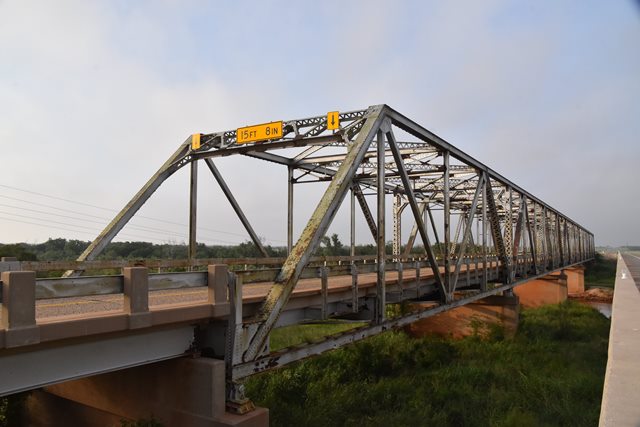We Recommend:
Bach Steel - Experts at historic truss bridge restoration.
BridgeHunter.com Phase 1 is released to the public! - Visit Now
TX-6 Brazos River Bridge

Primary Photographer(s): Nathan Holth
Bridge Documented: August 4, 2019
Rural: Knox County, Texas: United States
Metal 6 Panel Rivet-Connected Warren Through Truss, Fixed and Approach Spans: Metal 4 Panel Rivet-Connected Warren Through Truss, Fixed
1939 By Builder/Contractor: Virginia Bridge and Iron Company of Roanoke, Virginia and Oran Speer of Alvord, Texas
Not Available or Not Applicable
128.0 Feet (39 Meters)
755.0 Feet (230.1 Meters)
24 Feet (7.32 Meters)
3 Main Span(s) and 7 Approach Span(s)
251380009805036

View Information About HSR Ratings
Bridge Documentation
This bridge features a combination of continuous and simple spans, but was designed to look continuous throughout. The three center truss spans are continuous. However these are flanked by a single simple truss span. These simple spans are made to look like they are part of the continuous truss because they use vertical end posts at the piers. However, if you look closely you will see two vertical posts and two bearings at this point showing that the end spans and the center three spans are not connected in a continuous fashion. In addition to the truss spans, there are three stringer spans at the south end and two stringer spans at the north end.
This bridge was bypassed in 2014, but was left standing as a pedestrian crossing. Parking spaces were added at the south end of the bridge, along with interpretive signage.
View Archived National Bridge Inventory Report - Has Additional Details and Evaluation
View National Register of Historic Places Nomination Form For This Bridge
Above: Historical photo showing bridge construction, as well as previous 1901 pin-connected Pratt through truss bridge.
Information and Findings From Texas Historical CommissionHistoric Marker Text This bridge was constructed in 1938-39 to replace a 1901 bridge and provide a crossing over the Brazos River. Located on State Highway 6 (originally State Highway 16 and later State Highway 283) south of Benjamin, the bridge links the Knox County seat to points south. A statewide historic bridge survey in the 1990s identified it as one of only five continuous through truss bridges in Texas built before World War II. The design consists of a three-span continuous truss unit measuring 382 1/2 feet flanked by two simply supported truss spans each 96 feet long. The bridge has three steel I-beam approach spans on the south side and two on the north. The truss spans rest on reinforced concrete piers and the approach spans rest on a series of precast concrete pile bents. The 1901 bridge, consisting of four 119-foot Pratt through truss spans and two pony truss spans, was reported to be in seriously deteriorated condition by 1934. During construction of the new bridge immediately upstream of the old one, a pier of the old bridge subsided, requiring closing of the bridge and construction of a detour road. Texas highway department engineers developed a special design for the replacement bridge's truss spans, with a warren truss configuration with parallel top and bottom chords. Oran Speer of Alvord was the contractor, and the Virginia Bridge Company of Roanoke, Virginia, fabricated the steel truss spans. Construction began on May 2, 1938, the new bridge was open to traffic by January 11, 1939, and the project was officially completed on March 16, 1939, at a cost of about $138,000. In 1996, the bridge was listed in the National Register of Historic Places at the state level of significance. Bridge Considered Historic By Survey: Yes |
![]()
Photo Galleries and Videos: TX-6 Brazos River Bridge
Bridge Photo-Documentation
Original / Full Size PhotosA collection of overview and detail photos. This gallery offers photos in the highest available resolution and file size in a touch-friendly popup viewer.
Alternatively, Browse Without Using Viewer
![]()
Bridge Photo-Documentation
Mobile Optimized PhotosA collection of overview and detail photos. This gallery features data-friendly, fast-loading photos in a touch-friendly popup viewer.
Alternatively, Browse Without Using Viewer
![]()
Maps and Links: TX-6 Brazos River Bridge
Coordinates (Latitude, Longitude):
Search For Additional Bridge Listings:
Bridgehunter.com: View listed bridges within 0.5 miles (0.8 kilometers) of this bridge.
Bridgehunter.com: View listed bridges within 10 miles (16 kilometers) of this bridge.
Additional Maps:
Google Streetview (If Available)
GeoHack (Additional Links and Coordinates)
Apple Maps (Via DuckDuckGo Search)
Apple Maps (Apple devices only)
Android: Open Location In Your Map or GPS App
Flickr Gallery (Find Nearby Photos)
Wikimedia Commons (Find Nearby Photos)
Directions Via Sygic For Android
Directions Via Sygic For iOS and Android Dolphin Browser
USGS National Map (United States Only)
Historical USGS Topo Maps (United States Only)
Historic Aerials (United States Only)
CalTopo Maps (United States Only)


